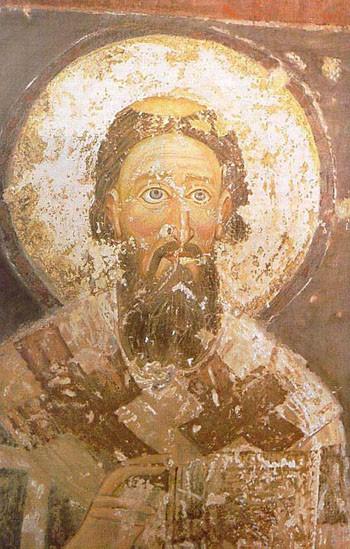- Saint Sava
Infobox Saint
name=Saint Archbishop Sava
Свети Сава
birth_date=ca. 1175
death_date=death date|1235|1|14|mf=y
feast_day=14 January (Gregorian calendar ),27 January (Julian calendar )
venerated_in=Eastern Orthodox Church 
imagesize=200px
caption=Fresco of Saint Archbishop Sava from theMileševa monastery
birth_place=
death_place=Tarnovgrad ,Bulgaria
titles=Archbishop of the Serbs
beatified_date=
beatified_place=
beatified_by=
canonized_date=
canonized_place=
canonized_by=
attributes=
patronage=Serbia andSerbs
major_shrine=Temple of Saint Sava (Belgrade )
suppressed_date=
issues=
prayer=
prayer_attrib=Saint Archbishop Sava (or saint Sabbas; Serbian: Свети Сава, "Sveti Sava") (
1175 -January 14 ,1235 ), originally the prince Rastko Nemanjić (Serbian: Растко Немањић) (son of theSerbia n ruler and founder of the Serbian medieval stateStefan Nemanja and brother ofStefan Prvovenčani , first Serbian king), is the firstArchbishop of Serbia (1219-1233), the most important saint in theSerbian Orthodox Church and important cultural and political worker of that time.Early life
Rastko was born ca. 1175 in Gradina (near modern-day
Podgorica ,Montenegro ).In his youth (c. 1192), he fled from his home to join the orthodox monastic colony on
Mount Athos (Holy Mountain on theChalkidiki peninsula) and was given the name Sava. He first traveled to aRussia n monastery and then moved to the Greek Monastery ofVatopedi . At the end of 1197 his father, who on becoming a monk was namedSimeon joined him. In 1198 they together moved to and restored the abandoned monasteryHilandar (Chilandari, in French) which, since that moment, became the center of Serbian Christian monastic life. Hilandar is one of the twenty monasteries on Mount Athos that still function, and its position in the hierarchy is fourth.St. Sava's father took the monastic vows under the name Simeon and died in
Hilandar onFebruary 13 1199 . He is also canonised, asSaint Simeon .erbian Orthodox Church
After his father's death, Sava devoted himself to the
ascetic life and retreated to askete close toKaryes which he built himself in 1199. He also wrote the Karyes Typicon valid for both for Hilandar and his skete. Thetypicon has been inscribed onto a marble board at the skete and still stands there. Sava stayed onAthos until the end of 1207.In 1208, Sava returned to Serbia, where the feuding between his brothers had created a state or anarchy. Sava set up his base at
Studenica monastery , and started to organize theSerbian Orthodox Church . He had brought with him several monks to help him perform his pastoral and missionary duty among the people. Sava eventually managed to free the Serbian church from the jurisdiction of theArchbishopric of Ohrid . In 1219, Sava was consecrated the firstarchbishop of the new Serbian Church byPatriarch Manuel I of Constantinople , who was then in exile at Nicaea.Saint Sava is considered the founder of the independent Serbian Orthodox Church and Serbian Orthodox Christians celebrate him as patron saint of education and medicine. His legislature (
Nomocanon of St. Sava) made him the fist Serbian legislator, being also important for thehistory of legal education in Serbia . He is commemorated onJanuary 27 according to theJulian calendar and onJanuary 14 according to theGregorian calendar . Since the 1830s, Saint Sava has become the patron saint of Serbian schools and schoolchildren. On his day, students partake in recitals in church.Fact|date=February 2007Sava died in
Turnovo , capital of theSecond Bulgarian Empire , during the reign ofIvan Asen II of Bulgaria . According to hisLife , he fell ill following theDivine Liturgy at theFeast of the Epiphany onJanuary 12 ,1235 . Sava visited Turnovo on his way back from theHoly Land , where he had founded ahospice for Syrian pilgrims inJerusalem and arranged for Serbian monks to be welcome in the established monasteries there. He died ofpneumonia in the night between Saturday and Sunday,January 14 ,1235 . [http://www.stsavanyc.org/english/e11/stsava.html] He was initially buried at theSt Forty Martyrs Church in Turnovo, but his holy relics remained there until onlyMay 6 ,1237 when they were translated to theMileševa monastery in southern Serbia. 360 years later, in 1595, theOttoman Turks unearthed his remains and took them toVračar hill inBelgrade where they were incinerated on a stake.The
Temple of Saint Sava inBelgrade , whose construction was planned in 1939, begun in 1985 and awaits completion by 2004, is the largest active Orthodox temple in the world today. It was built on the place where the bones were believed to have been burned. In reality, what is Vračar hill now used to be outside the city walls and not within easy reach. There used to be a different Vračar hill where today is located the Tašmajdan. This place was used by Ottoman Turks for executions and seems much more likely to have been the spot where Sava's relics were burnt. Also, tradition holds the place of burning as "Čupina Umka", the tallest point in Tašmajdan. [http://www.srpsko-nasledje.co.yu/sr-l/1998/02/article-02.html]Gallery
ee also
*
Hilandar Research Library " (Resource Center for Medieval Slavic Studies, University of Ohio (Columbus))
*Temple of Saint Sava inBelgrade Notes
External links and references
* [http://www.slavicnet.com/pls/lib/bib.search Online Library Cataloging System of Saint Sava]
* [http://www.sveti-sava.org.yu/eng/index.php Sveti Sava Society]
* [http://www.rastko.org.yu/knjizevnost/liturgicka/svsava-sabrana/index_c.html Collected works] (Serbian)
*Attwater, Donald and Catherine Rachel John. "The Penguin Dictionary of Saints". 3rd edition. New York: Penguin Books, 1993. ISBN 0-140-51312-4.
Wikimedia Foundation. 2010.
